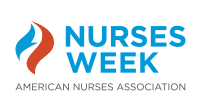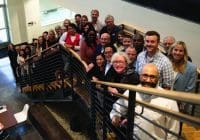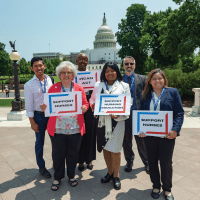The importance of strengthening member advocacy and engagement was the prevailing message and a focus of action at the American Nurses Association’s (ANA’s) Membership Assembly held June 9-10 in Washington, DC.
About 300 attendees gathered at the Assembly, including representatives from ANA’s constituent/state nurses associations (C/SNAs), Individual Member Division (IMD), and specialty nursing organizational affiliates (OAs), and observers. Eligible voting representatives also elected nurses to ANA leadership posts and adopted changes to the association’s governing bylaws.
President Pamela F. Cipriano, PhD, RN, NEA-BC, FAAN, opened this year’s Assembly by looking back at the theme of her 2016 Assembly speech, “Leading in a Changing World,” and its relevance today. She noted that since the outcome of the national elections on November 8, 2016, many nurses have been grappling with uncertainties surrounding the future of health care, human rights, climate change, and other important issues.
“November 8 was a watershed event in this country,” Cipriano said. “Everything began to change in our world.” She reported that the association delivered a letter outlining ANA’s Principles for Health System Transformation to President-elect Trump in December 2016, and she encouraged nurses to continue to use their voices to oppose the American Health Care Act of 2017 passed by the U.S. House of Representatives and being considered by U.S. Senators.
Cipriano also addressed the ongoing stress that many nurses are feeling—no matter what they think about the election results—and that this constant stress can lead to exhaustion. “Our responsibility is to find the path forward,” she said, adding that ANA has been focused on doing that for several months. “We realize it’s important to have resilience and adaptation and to continue our work.”
She further recounted some successful efforts of ANA and nurses, including helping nurse practitioners, certified nurse-midwives, and clinical nurse specialists gain full practice authority at Veterans Health Administration facilities and launching the Healthy Nurse, Healthy Nation Grand Challenge™.
Cipriano concluded by quoting Sir Winston Churchill: “Kites rise highest against the wind, not with it,” and encouraged nurses to continue to fight for what’s right.
“We have the strength in numbers,” she said. “We have the intellect. And it’s important that nurses are leading on this issue [of health care for all].”
Strengthening member advocacy
Focusing on a dialogue forum topic submitted by the Minnesota Organization of Registered Nurses (MNORN), participants engaged in small-group discussions on barriers, strategies, and resources to better prepare nurses to be effective advocates in an uncertain healthcare environment.
Among the identified barriers were nurses’ competing priorities, a lack of confidence in policy-focused advocacy, and fear of retaliation. Recommended strategies included increasing mentoring and networking opportunities and providing nurses with virtual options to engage in advocacy.
As part of the forum, ANA Past President Karen Daley, PhD, MPH, RN, FAAN, shared her personal story of advocating for safer sharps devices after she was stuck with a needle protruding from a sharps container and contracted HIV and hepatitis C.
“Most nurses are oriented to the one-on-one advocacy we practice with our patients,” said Daley, an ANA Massachusetts member, who noted that nurses may also engage in advocacy through legislative-focused activities, such as their state lobby day and ANA’s Hill Day. “But we always need to think more broadly when it comes to advocacy and go to different tools in our toolbox,” she said.
Daley’s advocacy strategies involved building coalitions, engaging stakeholders, finding champions, and understanding how important every interaction is to one’s cause. Because of her outreach efforts and the collective advocacy of ANA, C/SNAs, and nurses at the grassroots level, the U.S. House and Senate each unanimously passed safe-needle legislation, which President Bill Clinton signed into law.
Fostering member engagement
In a related forum proposed by the IMD, Assembly participants shared their ideas and practices on fostering member engagement in association policy development. This greater engagement will help guide policy development to ensure that ANA, the C/SNAs, the IMD, and the OAs are strategically positioned as the healthcare landscape continues to evolve.
Participants raised challenges to strengthening member engagement, including nurses’ time constraints, lack of awareness about the association’s broadbased work, and burnout from high workloads. They also offered strategies, such as mentoring nurses on association opportunities, developing a database of nurse experts, and providing incentives for innovation.
Speaker Kathi Koehn, MA, RN, FAAN, executive director of MNORN, described a formal process the organization uses to gain members’ input on priority issues they’d like to see addressed at ANA’s Assembly. And steering committee co-chair of ANA’s Barriers to RN Scope of Practice Professionals Issues Panel, Kathy Baker, PhD, RN, NE-BC, noted that the important focus of the panel—nurses being able to practice to the top of their scope—lent itself to member engagement. Further, members remained engaged because they could see progress toward completing that goal.
Taking action
Following the forums, Assembly voting representatives recommended that ANA:
• highlight and promote the use of policy and advocacy resources
• emphasize policy development and advocacy as central to the role of all RNs
• use advance mechanisms to heighten the involvement of individual RN members in the generation of policy and advocacy topics.
In another action, eligible voting representatives adopted several bylaws changes, including one that expands the total number of voting seats to the Assembly to allow for more member engagement. Another change allows C/SNAs to include non-RNs, such as LPNs and respiratory therapists, in their membership. They would not be joint ANA members. Assembly representatives also formally went on the record to reaffirm ANA’s opposition to the American Health Care Act of 2017 passed by the House and to continue to promote ANA’s Principles for Health System Transformation.
Future-focused, other opportunities
In her presentation, ANA CEO Marla Weston, PhD, RN, FAAN, highlighted some of ANA’s achievements, including successfully amplifying nursing’s voice through a variety of social media channels, electronic communications, and media interviews and by facilitating RN leadership in boardrooms across the country. She also addressed ongoing and future initiatives, including professional issues panels on moral resilience and “connected care,” which encompasses telehealth and other electronic communication between a patient and a provider.
Weston then spoke of the importance of designing a healthcare system and nursing association for a future world and gave examples of emerging technologies that are already changing nursing practice and health care.
Assembly participants and observers also had the opportunity to network and participate in ANA’s Political Action Committee (ANA-PAC) and American Nurses Foundation events, as well as attend lunchtime discussions on topics ranging from assessing the ethical climate to palliative care to social media advocacy and engagement. The ANA-PAC raised more than $33,000, and the Foundation raised more than $15,000 to further their missions.
Susan Trossman is a writer-editor for ANA.

















